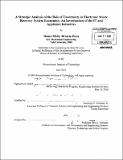| dc.contributor.advisor | Randolph E. Kirchain, Jr. | en_US |
| dc.contributor.author | Brown-West, Boma Molly | en_US |
| dc.contributor.other | Massachusetts Institute of Technology. Technology and Policy Program. | en_US |
| dc.date.accessioned | 2010-10-29T18:07:45Z | |
| dc.date.available | 2010-10-29T18:07:45Z | |
| dc.date.copyright | 2010 | en_US |
| dc.date.issued | 2010 | en_US |
| dc.identifier.uri | http://hdl.handle.net/1721.1/59670 | |
| dc.description | Thesis (S.M. in Technology and Policy)--Massachusetts Institute of Technology, Engineering Systems Division, 2010. | en_US |
| dc.description | Cataloged from PDF version of thesis. | en_US |
| dc.description | Includes bibliographical references (p. 142-146). | en_US |
| dc.description.abstract | The volume of electronic waste is growing at an increasing rate. The extensive adoption of electronic products, the tendency of consumers to purchase multiple electronics, and the rapid obsolescence of products are contributing factors. More problematic than the growing volume of e-waste is where to put it. Environmental recovery is an option that is not often utilized, lagging far behind landfill disposal. Low collection volumes and uncertain valuations of recovered products make the economics of e-waste recovery unpredictable. Thus, firms see it as a costly endeavor. To make e-waste recovery more successful, firms must understand what aspects of the system affect profitability and how to mitigate the uncertainty around economic performance. The economics of e-waste recovery in the IT and home appliance industries is examined through a mass flow and economic model, in which system parameters, such as product mix, retirement age, material compositions, and scrap commodity prices, and their uncertainties are incorporated. A series of sensitivity analysis reveals that the expected profit of a recovery system is highly dependent on product mix and product age. The original price (or quality) of incoming products is also a large determinant of a product's fate, i.e. recycling or reuse. In evaluating system performance under possible future scenarios, it is determined that the best option to improve profitability may be to promote the return of younger products, so that reuse activities can be better exploited. However, implementing such a strategy in the IT industry could have detrimental effects on the energy savings currently achieved from environmental recovery. If consumers are not encouraged to buy used products, the early disposal of purchases will lead to a faster rate of production. In many cases, the energy saved by recycling and reuse cannot offset the energy of new manufacturing. Meanwhile, early recovery of appliances would still result in a net energy benefit, but the rate of recovery would have to increase to maintain the current level of energy savings achieved from recycling and reuse. | en_US |
| dc.description.statementofresponsibility | by Boma Molly Brown-West. | en_US |
| dc.format.extent | 166, [2] p. | en_US |
| dc.language.iso | eng | en_US |
| dc.publisher | Massachusetts Institute of Technology | en_US |
| dc.rights | M.I.T. theses are protected by
copyright. They may be viewed from this source for any purpose, but
reproduction or distribution in any format is prohibited without written
permission. See provided URL for inquiries about permission. | en_US |
| dc.rights.uri | http://dspace.mit.edu/handle/1721.1/7582 | en_US |
| dc.subject | Engineering Systems Division. | en_US |
| dc.subject | Technology and Policy Program. | en_US |
| dc.title | A strategic analysis of the role of uncertainty in electronic waste recovery system economics : an investigation of the IT and appliance industries | en_US |
| dc.type | Thesis | en_US |
| dc.description.degree | S.M.in Technology and Policy | en_US |
| dc.contributor.department | Massachusetts Institute of Technology. Engineering Systems Division | |
| dc.identifier.oclc | 668117021 | en_US |
